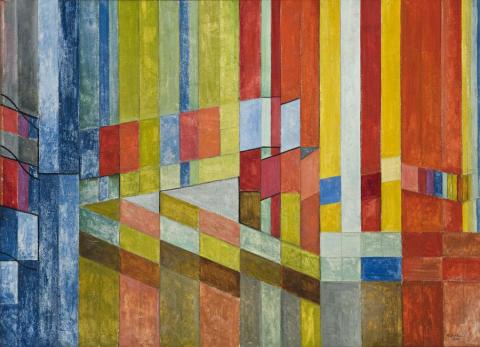ARRESTED MOVEMENT FROM A TRIO, 1935
Roy de Maistre
oil on board
71.5 x 98.0 cm
signed and dated lower right: R. de Maistre 1935
Dimitrije Mitrinovic, United Kingdom
Trustees of the New Atlantis Foundation, United Kingdom
Gladys MacDermot, London
Thence by descent
Private collection, Switzerland
Sotheby's, Melbourne, 24 November 2008, lot 72
Private collection, Victoria
Roy de Maistre: A Retrospective Exhibition of Paintings and Drawings 1917–1960, Whitechapel Art Gallery, London, May – June 1960, cat. 35
Johnson, H., Roy de Maistre: The English Years 1930–1968, Craftsman House, Sydney, 1995, pp. 80, 86
Eagle, M., Australian Modern Painting Between the Wars 1914–1939, Bay Books, Sydney, 1989, p. 51, pl. 33 (illus.)
Arrested phrase from Haydn Trio in orange-red minor, 1935, Collection of the National Gallery of Australia, Canberra
Arrested phrase from Beethoven's Ninth Symphony in red major, 1935, Collection of the National Gallery of Australia, Canberra
Colour Composition derived from three bars of music in the key of green, 1935, private collection
The relationship between sound and colour has long fascinated artists for music and art are closely related, reflected even in the sharing of such terms as composition, harmony, and the like. This interest increased during the early years of the modern movement with the rise of abstraction with artists admiring music's independence in its freedom from the imitation of nature. For many music became a model, influences being mutual. There was Claude Debussy and his 'impressionistic' music, Igor Stravinsky's 'cubism', and the massive impact of the Ballets Russes on the arts in Paris at the beginning of the twentieth century. No artist, Picasso included, escaped its impact. The profound influence of music on Henri Matisse is seen in his masterly painting Dance, 1909-10, in The Hermitage, St Petersburg. And the Australian international master Rupert Bunny, also a gifted pianist, imbued his art with the mood and colour of music. Significantly, the impact of Arnold Schoenberg's atonal music on Wassily Kandinsky was a revelation as he turned to abstract painting and expounded his ideas on the relationship between sound and colour in his impressive Über das Geistige in der Kunst (Concerning the Spiritual in Art) published in 1911.
Australia's contribution to this international movement is found in the early work of Roy de Maistre and Roland Wakelin. They theorised on the analogies between the colour spectrum and the musical scale, painted colour wheels, discs and keyboards, and held a joint exhibition, Colour in Art, at Gayfield Shaw's Sydney gallery in 1919. While Wakelin's paintings were usually landscape based, de Maistre moved to the purely abstract in his Rhythmic Composition in Yellow Green Minor, 1919, now housed in the collection of the Art Gallery of New South Wales. Colour saturation was the keynote, as in Arrested Movement from a Trio, painted in London in 1935 upon his return to his earlier interests. The series he painted at this time include the two grand works in the collection of the National Gallery of Australia, Canberra, Arrested Phrase from a Hayden Trio in Orange-Red Minor and Arrested Phase from Beethoven's Ninth Symphony in Red Major. As they are based on specific musical works, it is not unreasonable to assume that Arrested Movement from a Trio has a similar association. Their titles also emphasise the arrest of movement, playing with ideas that music requires time to be experienced while painting can be enjoyed in a moment. Richer enjoyment, however, is found in the progressive unwinding of the paintings reductive colours and forms, their play of harmonies and contrasts, and the cool intellectual control in which clarity and seeming simplicity of design touches on profundities.
DAVID THOMAS
